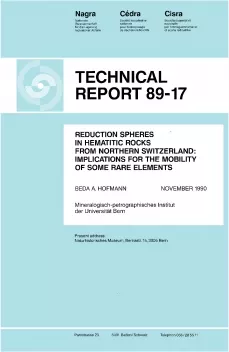
Technical Report NTB 89-17
Reduction spheres in hematitic rocks from Nortern Switzerland:Implications for the mobility of some rare elements
Reduction spheres are small-scale, isolated redox systems occurring in hematite-stained rocks of variable age, origin and provenience. Reduction spheres from Permotriassic continental red beds and from basement rocks of Northern Switzerland have been studied mineralogically and geochemically. More than 40 authigenic minerals occur in the dark, mineralized cores of the spheres. The most common minerals are roscoelite, uraninite and nickel arsenides, but minerals containing the precious metals Ag, Au, Pd and Pt, selenides and REErich uraninite have been found as well. The bleached spheres are depleted in ferric iron due to hematite dissolution. Mass balance calculations show that only a minor part of the trace elements present in the bulk rock has been mobilized during halo formation. The relative mobilities are: As > U > Ni > V. The elements precipitated as ore minerals in reduction sphere cores were probably released from iron hydroxides during their alteration to hematite. The red beds which contain reduction halos are unusually rich in As (100 ppm) compared with underlying reduced beds containing less than 5 ppm As. Reduction halo formation took place during the Mesozoic at depths of burial of 500 to 1'100 m. The porewaters were highly saline. Organic matter of unknown origin reacted with dissolved high-valence ions and hematite at discrete, randomly distributed sites in the rocks and caused local precipitation of rare elements as ore minerals and dissolution of hematite. Element migration was diffusive. Oxidation of organic matter and ore mineral precipitation was probably catalyzed by bacteria because the sulphides were formed by in situ low-temperature (< 100°C) sulphate reduction. Reduction spheres can be used to date and trace quantitatively element mobilities during red bed diagenesis. The geological significance of their presence is not yet understood.
Reduction spheres give qualitative information on element mobilities in an environment similar to that of a possible radioactive waste repository in Northern Switzerland. Diffusive element transport of U, REE, Pd and many other elements under oxidizing conditions is evidenced as well as immobilization of these elements by very local reducing conditions. Very high concentration gradients of U and other elements at redox boundaries persisted for roughly 108 years.
